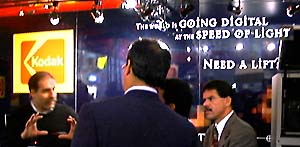
New Orleans, Louisiana, USA. 20 February 1997
'The world is going digital at the speed of light.'
Not my words but an inscription on the Eastman Kodak stand here at the PMA
trade show. When you bear in mind that this is from a company whose salaries
are still mostly paid by silver halide earnings, you realise how much the
photographic world is caught in a digital tornado. I am not spending any of your
subscription here in New Orleans, I am here at my own expense, to research for forthcoming presentations in New York and Sydney, Australia.

PMA - the Photo Marketing Association International - has more than 17,000
members in over 100 countries. Most of those members are retailers, processors
and repairers. Frank Hatton heads the PMA's presence in the UK - and what
a presence. His melodious voice and imposing stature would not be out of
place on the stage of the Royal Shakespeare Company but, instead, he has
completed over fifty years service to photography.
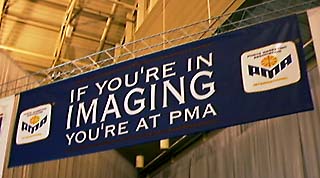
This is definitely a marketing conference and exposition. There is a
peculiar dearth of professional photographers - apart from one conference
session by Monte Zucker, teaching retail portrait studios how to run a successful
portrait and wedding business. There is, of course, a high reliance on good
photography - used to demonstrate new products and as visual wallpaper.
The latest film or paper would be meaningless without fine images to demonstrate
its potential.
Running alongside PMA are a number of special interest group conferences
and it was one of these, DIMA, which particularly interested me. The Digital
Imaging Marketing Association held its second annual conference the day
before the PMA show opened. DIMA was massively over-subscribed, with standing-room
only and sessions overflowing into the hallways. Of a membership of around
4,000, about 1,250 turned up for the conference, such is the interest in
digital imaging.
Unfortunately DIMA sessions did not measure up to the hype in the brochure,
apart from one or two notable exceptions. I expected to hear How To Make
Money From Digital Imaging but maybe those who know are busy keeping it
to themselves.One of the exceptions was an inspirational keynote from Alvin
Toffler about the economy of the future, as opposed to the future of the
economy. His views about how we can benefit as the digital revolution changes
the world can either be seen as crazy or pointers to great opportunity.
I resolved to read his latest book, 'Creating a New Civilization'.

I come to America for inspiration and fixes of intravenous enthusiasm
and adrenalin. I love the way Americans adopt new ideas with vigour, unashamed
to go in search of the dollar. Of course, larger than life Americans sometimes
exude larger than life sincerity but, make no mistake, they know precisely
who butters their bread: their trade customers. So even the top brass are
here. This Is Certainly Where The Money In Photography Is At.
It's also a place of enigmas. I bumped into the owner of a purely digital
bureau in London's West End. He's never been involved in 'wet' imaging but
is here - will you believe it? - to buy a mini-lab. Not only will this help
feed his Photo-CD PIW but he sees other areas of profit.
The trade show, which opened today, more than satisfied my cravings. The
buzz is electrifying, the show like a manageable Photokina, making our own
'Focus on Imaging' look like the parish church fete. That's not intended
as a criticism of organiser Mary Walker but of the British photo industry.
But who timed 'Focus' to overlap PMA? I met some Brits who said they would
not be at 'Focus' because focus is what it lacks. There are no tyre kickers
here, PMA is strictly for the trade. Those less critical will be red-eyeing
it back across the pond to be at ( or in) Focus on Sunday morning, early
if not bright.
The PMA show runs for four days and although I haven't yet had time to see
it all our deadline dictates that I must file this report by eMail tonight.
This also means no pictures, though you can find the 'colour supplement'
with pictures on the Internet at http://www.epicentre.co.uk/reports/cs9703.html.
Just about every commercial on television, every business in the street,
every package, seems to advertise a website. It's obviously part of the
basic street cred over here.
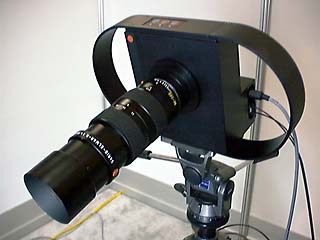
The need for every camera manufacturer to have a digital camera continues
to expand. Even Leica are showing a prototype digital camera and its oval
shape is reminiscent of Oskar Barnack's first Leica, eighty years ago. The
early Leicas were made from flattened aluminium tube, the S1 has an oval
hoop. It's a 'scanner camera' which takes R- and M-series lenses. Expect
to see it late this year.
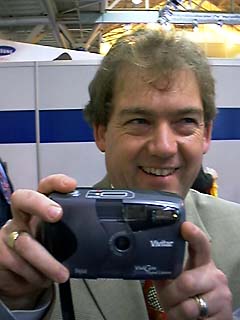
Vivitar launched their first digital camera, the ViviCam 3000, with 1000
x 800 pixel resolution. Looking like a 35mm compact, the camera idea was
born in Britain and in fact uses a British sensor - not a CCD but the new
C-MOS technology, made in Scotland. C-MOS technology has been under development
for some time and promises many advantages over CCD when development reaches
maturity.
Many of the control circuits which are now on separate boards will be able
to be incorporated on the chip itself, reducing size down to about one tenth
and giving us 'camera on a chip' possibilities. C-MOS uses only 10 to 50
milli-Watts of power, compared with the 1 to 5 Watts consumed by comparable
CCDs. This means battery life of one hundred times more. Cost should be
around half that of CCDs, though initial production runs need to be in excess
of 100,000.
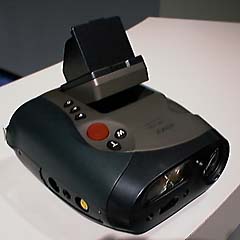
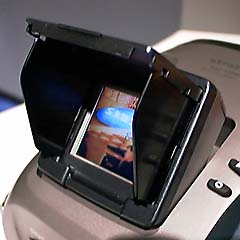
Samsung showed a new 768 x 494 pixel CCD digital camera, the Kenox SSC-410N,
which uses Compact Flash Card removable media and has a three-to-one zoom.
Like many other digital cameras, the Samsung has a colour LCD viewfinder
but they have had the good sense to make this tilt and have given it a folding
hood to keep out ambient light. I suggested to the Korean designer that
a pop-up magnifier would also be a good idea.
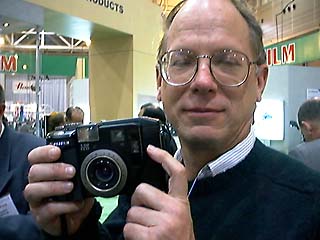
Fuji have put their 1.3 megapixel CCD chip (the same one that's in the
DS-505/515 digital SLRs) into a body reminiscent of the GA645 medium format
roll-film camera. Products arrived in the USA only the night before the
show and I couldn't get near when I went to the Fuji booth because of the
surrounding crowds of Japanese - all from competitive companies! The new
camera is the DS-300 and has a list price of only $2800 and expected street
price of $2495. It has a cast magnesium body and takes a standard-sized
PCMCIA card. Image processing, and thus picture quality, is claimed to be
superior to the DS-505/515. The A5 prints on a Pictrography 3000 were superb.
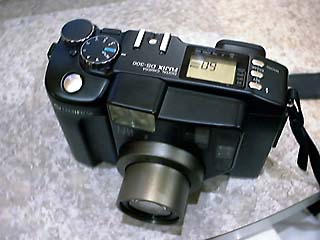
Will new firmware now be made available for the older SLRs? Or will their
prices drop? The DS-300 is well thought out with a three-to-one optical
zoom (equivalent to 35 to 105mm on a 35mm camera) and two-to-one digital
zoom. It can be connected direct to a printer, cutting out the need for
a computer. An optional base ($900 list), rather like a digital motor drive,
contains more RAM, allowing bursts of twelve images to be captured at 4.5
frames per second. It also provides a SCSI connection. Video out means that
an inexpensive third-party LCD monitor could be used as a viewfinder/reviewer.
The only thing I didn't like was the absence of eyepiece adjustment on the
viewfinder. Maybe Fuji don't realise that old photographers don't die -
they just go soft.

Digital cameras are everywhere here in New Orleans, already prominently
displayed in the front of the consumer electronic stores in Canal Street.
As I snapped one of the window displays a salesman came out to chat. Pointing
to the 35mm compact cameras he told me that they would all be dead within
three years. Of course, he's completely wrong.
The variety of accessory products at this show is astounding. Row after
row of small booth selling laminators, albums, frames, mounters, lenses,
batteries, vacuum easels, light-boxes, financial services, insurance and
... night vision. In the second World War, Night Vision was something you
got from eating carrots. Now you can get a device for $8,500 which fits
between your lens and digital camera body to give up to ten f-stops of gain.
Ideal for surveillance, law enforcement and black cats in coal cellars.
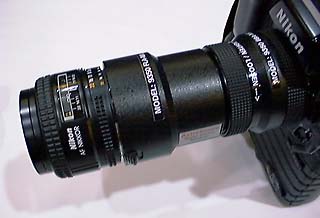
I can't wait to get back to the show tomorrow to do the other half of
the hall. Might even find time for a 'Hurricane' in Bourbon Street. Then
it's back to blighty and 'Focus' on Monday - jet lag permitting.